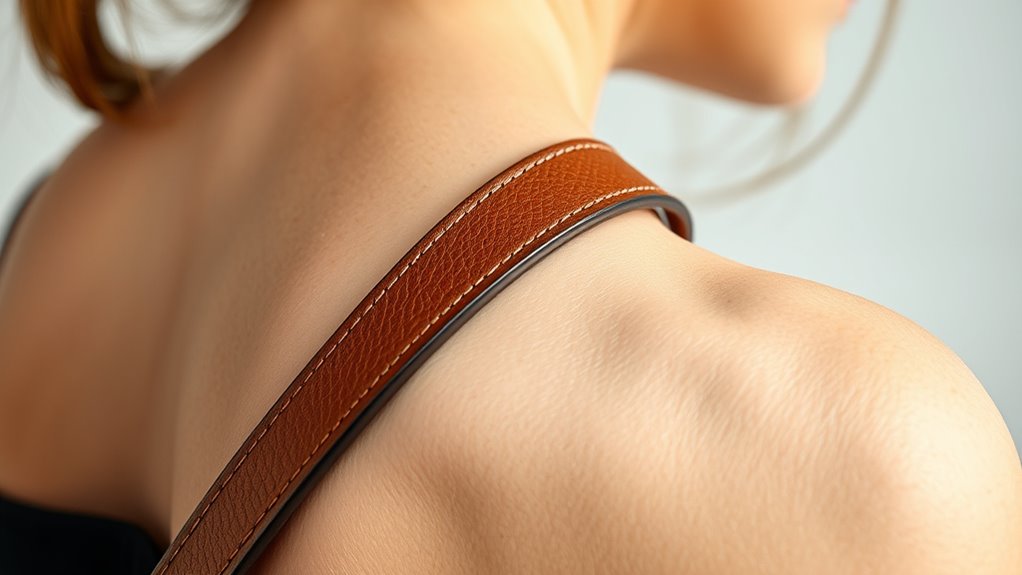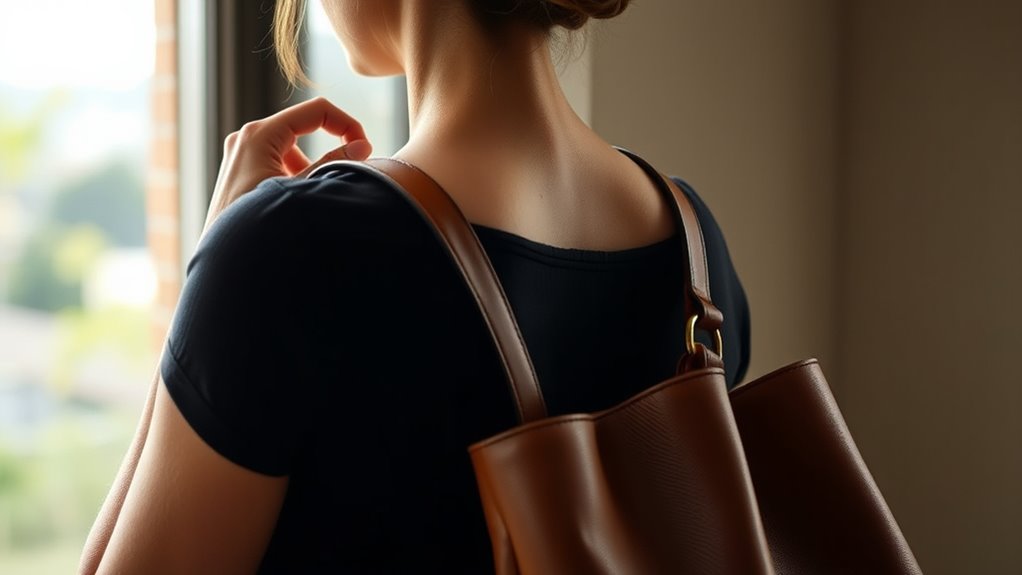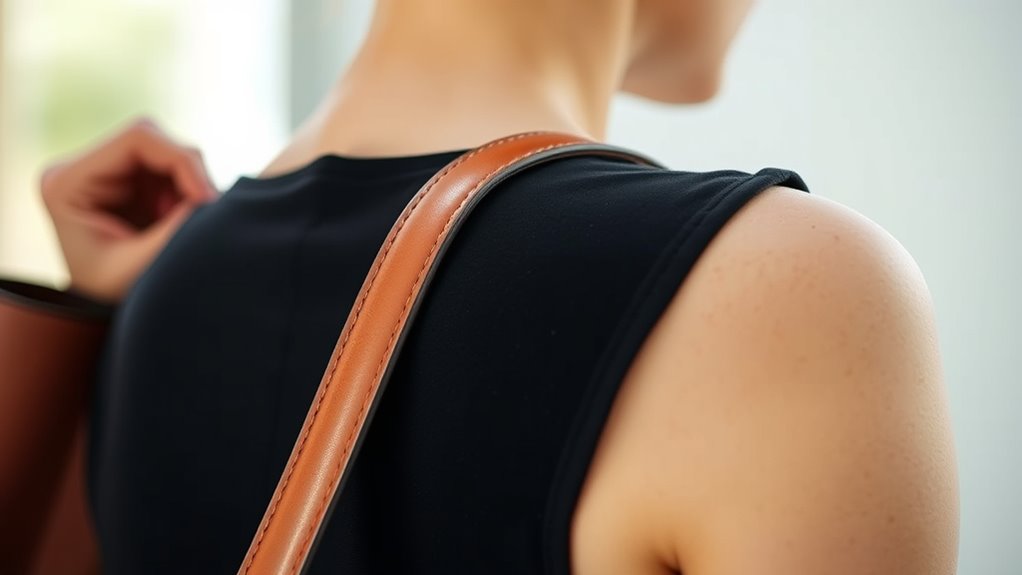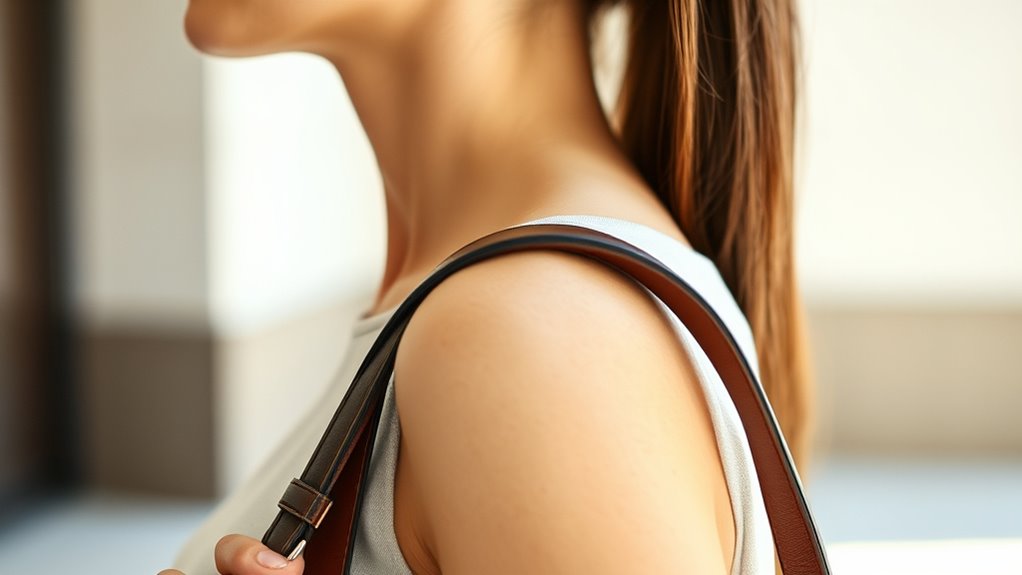Handbag straps can substantially impact your posture by how they distribute weight across your shoulders. Narrow or stiff straps often dig in, leading to uneven load and muscle strain, especially if your bag is heavy or poorly balanced. Adjustable, wider straps help spread pressure evenly, reducing discomfort and supporting spinal alignment. If you’re curious about how to prevent these issues and promote better posture, there’s more to think about that can make a real difference.
Key Takeaways
- Narrow, stiff straps can dig into shoulders, causing discomfort and uneven load distribution that affects spinal alignment.
- Wide, padded straps help distribute weight evenly, reducing muscle strain and promoting better posture.
- Carrying a bag on one shoulder shifts balance, leading to muscle imbalance and postural issues over time.
- Adjustable straps enable proper fit, keeping weight close to the body and preventing awkward postures.
- Heavy or poorly balanced handbags increase strain on neck and back muscles, risking long-term musculoskeletal problems.
The Anatomy of a Handbag Strap and Its Impact on Your Body

The design and materials of a handbag strap directly influence how your body bears its weight. Handbag design affects weight distribution, with wider straps offering more comfort by spreading pressure across your shoulder. Narrow straps tend to dig in, causing discomfort and strain over time. Strap materials also matter; leather is durable and molds to your body, reducing pressure points, while synthetic materials might cause irritation or slip. Heavier bags require sturdy, well-designed straps to prevent uneven load on your posture. If the strap is too thin or made from rough materials, it can lead to shoulder pain or misalignment. Incorporating natural materials into strap design can enhance comfort and reduce strain by providing a softer, more adaptable fit. Choosing the right handbag design and strap materials helps you carry weight more comfortably, minimizing negative effects on your posture during daily use.
Common Types of Handbag Straps and Their Postural Effects

Different types of handbag straps can considerably affect your posture and comfort throughout the day. Fashion trends influence strap styles, from thin chains to wide, padded straps. Thin straps, often seen in trendy handbags, can dig into your shoulder, causing discomfort and uneven weight distribution, which may strain your neck and back. Wide straps made from softer handbag materials distribute weight more evenly, reducing postural stress. Crossbody straps keep weight balanced across your body, encouraging better posture, while single shoulder straps often lead to uneven load, prompting you to lean or tilt your posture. Your choice of handbag materials also plays a role; softer materials tend to be more comfortable, but the strap design ultimately impacts how your body responds during extended wear. Incorporating appropriate strap technology can help improve weight distribution and reduce strain, leading to better posture over time.
How Uneven Weight Distribution Can Lead to Musculoskeletal Strain

When your handbag’s weight isn’t evenly distributed, it can cause your muscles to work harder to maintain balance, leading to musculoskeletal strain. Fashion trends often influence how you carry your bag, but uneven weight distribution from heavy or poorly balanced bags strains your neck, shoulders, and back. Handbag materials also play a role; bulky or stiff materials can make even weight distribution difficult. If you tend to carry your bag on one shoulder or switch sides frequently, your muscles compensate, causing imbalance and discomfort over time. This uneven load stresses your spine and joint structures, increasing the risk of pain and injury. Staying mindful of how your handbag’s weight is distributed helps prevent these issues and supports better posture. Incorporating ergonomic habits can prevent injury and promote healthier musculoskeletal function.
Signs Your Handbag Might Be Causing Postural Problems

Noticing discomfort or pain after carrying your handbag is a clear sign it may be causing postural problems. If you often feel shoulder tension, neck strain, or back soreness, your handbag could be a culprit. Look at how your bag interacts with fashion trends—clutches, oversized totes, or crossbody styles—all influence posture. Heavier or stiff handbag materials like thick leather or dense fabrics can add strain. Visualize this:
| Fashion Trend | Handbag Materials | Postural Impact |
|---|---|---|
| Oversized Totes | Thick Leather | Uneven weight distribution |
| Crossbody Bags | Dense Canvas | Shoulder imbalance |
| Clutches | Firm Synthetic | No strap support |
| Backpack Styles | Heavy Denim | Asymmetrical strain |
| Chain Straps | Metal or Plastic | Increased shoulder tension |
If your handbag prompts persistent aches, it’s time to reconsider your choices for better posture.
The Role of Strap Length and Adjustability in Spinal Health

The length and adjustability of your handbag straps play a crucial role in maintaining spinal health. If your strap length is too short, you may constantly lift your shoulder or lean to balance the weight, causing strain. Conversely, a strap that’s too long might cause the bag to hang unevenly, forcing you to compensate with poor posture. Strap adjustability allows you to customize the fit, ensuring the bag rests comfortably close to your body. Ideally, the strap should be adjustable enough to keep the weight evenly distributed across both shoulders, minimizing uneven tension. Proper strap length and adjustability help you avoid awkward postures, reducing the risk of neck, shoulder, and back pain. Paying attention to these details can make a significant difference in your spinal health. Embracing creative practice by exploring different ways to carry your bag can also help you develop better posture habits over time.
Expert Advice: Best Practices for Carrying Your Handbag

Choosing the right way to carry your handbag can make a noticeable difference in preventing discomfort and maintaining good posture. To stay safe and stylish, consider these best practices:
- Switch sides regularly to avoid uneven strain.
- Opt for lightweight handbags made from comfortable materials aligned with current fashion trends.
- Use both straps if possible, distributing weight evenly across your shoulders.
- Keep your handbag close to your body to reduce strain on your neck and back.
Choosing the Right Bag and Strap for Your Posture

Selecting the right bag and strap can considerably improve your posture and prevent discomfort throughout the day. When choosing a handbag, consider current fashion trends that prioritize ergonomic design, such as crossbody styles or bags with adjustable straps. The materials of your handbag also matter; lightweight options like leather or fabric reduce strain compared to heavy or stiff materials. Opt for a strap width that distributes weight evenly, preventing pressure points. Look for features like padded straps or multiple carrying options to adapt to different postures. By selecting a bag aligned with both style and comfort, you can minimize uneven weight distribution and avoid strain. Additionally, understanding how proper bag weight distribution impacts your posture can help you make better choices. Ultimately, choosing the right bag and strap is key to maintaining good posture and reducing discomfort during daily activities.
Exercises and Stretches to Counteract Strain From Handbag Carrying

To relieve tension from carrying a handbag, try shoulder roll exercises to loosen up tight muscles. Incorporate neck stretch techniques to reduce stiffness and improve flexibility. Don’t forget upper back loosening exercises to help maintain good posture and prevent strain. Additionally, practicing ergonomic awareness can help you adjust how you carry your bag to minimize discomfort.
Shoulder Roll Exercises
Shoulder roll exercises are a simple yet effective way to relieve tension caused by carrying a handbag on one shoulder. They help counteract postural imbalances from fashion trends that favor stylish yet heavy bags with less durable materials. To get started:
- Sit or stand with your back straight.
- Lift your shoulders towards your ears.
- Roll them back in a circular motion.
- Repeat 10 times, then switch directions.
These exercises loosen tight muscles and improve mobility. Incorporate shoulder rolls into your routine to reduce strain and prevent discomfort. Regular practice can help maintain better posture despite the weight and material durability of your favorite handbags, ensuring you stay comfortable and aligned throughout your day.
Neck Stretch Techniques
Carrying a handbag on one shoulder often leads to tension and stiffness in the neck muscles, which can cause discomfort and posture issues over time. To counteract this strain, try neck stretch techniques that target tight muscles. Gently tilt your head toward your shoulder, holding for 15-20 seconds, then switch sides. You can also rotate your neck slowly in a circular motion to release tension. Keep your shoulders relaxed and avoid tensing your jaw. Remember, fashion trends and handbag material influence how much strain you experience; heavier or stiff materials increase tension. Regularly performing these stretches can help restore balance and reduce discomfort caused by carrying handbags that may not align with your current style. Consistent practice keeps your neck muscles flexible and minimizes strain.
Upper Back Loosening
Since carrying a handbag on one shoulder can create tension in your upper back, performing targeted exercises and stretches can help release that strain and restore mobility. Focusing on improving handbag ergonomics and strap flexibility is key. Try these four techniques:
- Shoulder Blade Squeezes: Sit or stand, squeeze your shoulder blades together, hold for 5 seconds, then release. Repeat 10 times.
- Chest Stretch: Clasp your hands behind your back and gently lift them, opening your chest and relieving upper back tightness.
- Cat-Cow Stretch: On hands and knees, alternate arching your back upward and downward to loosen the upper back muscles.
- Thoracic Rotation: Sit or stand, place one hand behind your head, and gently rotate your upper body to each side, promoting mobility.
These exercises counteract handbag strain and support better posture. Incorporating proper pinball ergonomics can also help prevent postural issues associated with handbag use and promote overall back health.
The Long-Term Consequences of Poor Handbag Strap Choices

Choosing the wrong handbag strap can lead to serious long-term health issues that you might not notice right away. Constantly relying on thin, heavy, or poorly supportive straps can cause chronic pain, misalignment, and muscle imbalance. Over time, your posture suffers as your body compensates for uneven weight distribution. Fashion trends and handbag materials often prioritize style over support, increasing risks. The table below shows the emotional toll of poor choices:
| Emotional Impact | Physical Consequences | Long-Term Effects |
|---|---|---|
| Frustration | Neck pain | Chronic discomfort |
| Anxiety | Shoulder strain | Postural deformity |
| Embarrassment | Back fatigue | Reduced mobility |
| Stress | Headaches | Decreased quality of life |
| Regret | Muscle imbalance | Long-lasting damage |
Tips for Maintaining Good Posture While Using Your Handbag

Maintaining good posture while using your handbag is essential to prevent long-term health issues. To do this, consider these tips:
- Choose handbags aligned with current fashion trends that have wider, padded straps to distribute weight evenly.
- Opt for lightweight handbag materials, like leather or high-quality fabrics, to reduce strain on your shoulder and neck.
- Switch sides regularly to avoid uneven muscle development and strain.
- Keep your handbag close to your body, at waist level, avoiding dangling straps that can pull your posture forward.
Frequently Asked Questions
How Can I Tell if My Handbag Strap Is Harming My Posture?
You can tell if your handbag strap is harming your posture by paying attention to discomfort or pain in your shoulder, neck, or back. Check your strap length—if it’s too long or uneven, it can cause uneven weight distribution, straining your muscles. Notice if you’re constantly adjusting or carrying your bag on one side. Proper strap length and balanced weight help prevent postural issues.
Are There Specific Materials That Reduce Postural Strain?
When choosing a handbag strap, look for materials that reduce postural strain, like soft, adjustable options. Leather is durable and molds comfortably to your shoulder, minimizing discomfort. Opt for straps with adjustability so you can customize the length for better weight distribution. This helps prevent unnecessary strain on your neck and shoulders, keeping your posture healthier and more aligned throughout the day.
Can Switching Handbag Styles Improve My Spinal Health?
Ever wondered if changing handbag styles can boost your spinal health? Yes, switching to a bag with a lighter strap weight and adjustable strap length can make a difference. Opt for bags that distribute weight evenly and avoid overly long straps that cause imbalance. By choosing the right style, you help reduce strain on your shoulders and back, keeping your posture healthier and more comfortable throughout the day.
How Often Should I Take Breaks From Carrying a Handbag?
You should take breaks from carrying your handbag regularly to protect your posture. Aim for daily stretching to loosen tight muscles and improve flexibility. Also, pay attention to weight distribution, ensuring your bag isn’t too heavy on one side. Switch hands often and consider lighter bags to reduce strain. Taking these steps helps prevent discomfort and promotes better spinal health, especially if you carry your bag frequently throughout the day.
Do Ergonomic Handbag Designs Exist for Better Posture Support?
You’ll find plenty of ergonomic handbag designs that focus on strap comfort and handbag ergonomics, making it easier to carry your essentials without straining your posture. These bags often feature padded straps, adjustable lengths, and balanced weight distribution to reduce shoulder and back stress. By choosing ergonomic options, you support better posture, minimize discomfort, and enjoy greater comfort throughout your day. Look for brands that prioritize strap comfort and ergonomic features.
Conclusion
If you ignore your handbag straps, you might as well carry a mountain on your shoulder, warping your posture into a crooked, lopsided mess! Choosing the wrong strap could turn your daily walk into a spinal circus act, with aches and pains crashing the show. But if you pick wisely, adjust your bag properly, and stay mindful, you’ll keep your posture strong enough to hold up skyscrapers—no exaggeration needed!









